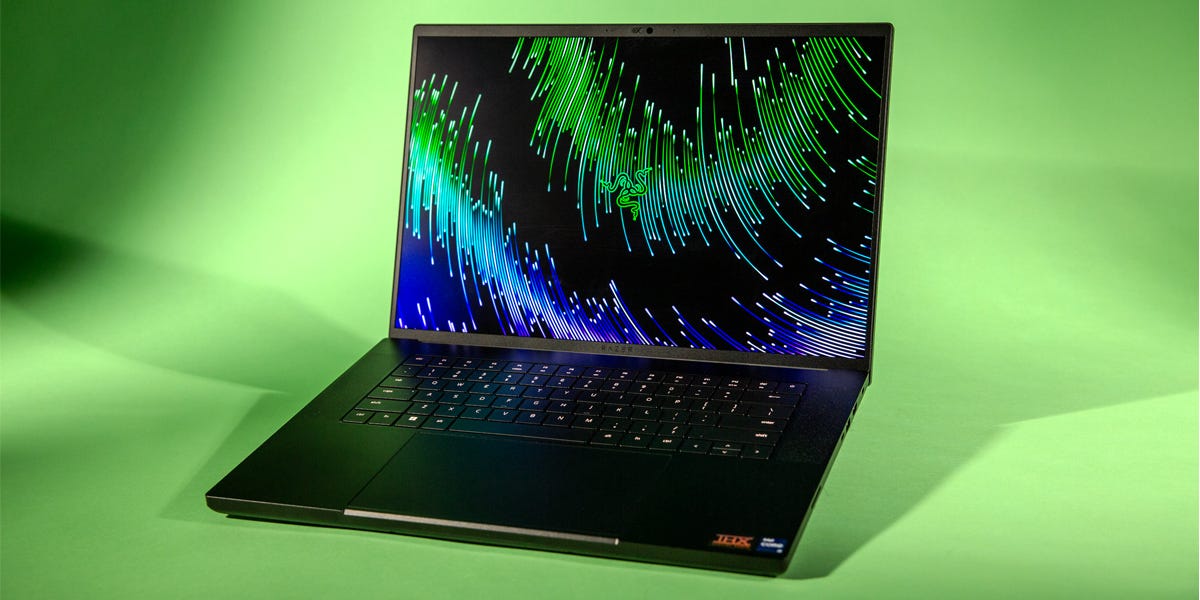When you buy through our links, Insider may earn an affiliate commission. Learn more
Over the years, Razer has gained a reputation for producing dozens of flashy, neon-lit, and occasionally gaudy gaming accessories. If you’re a PC gamer, there’s a decent chance you’re using a Razer mouse, keyboard, or headset right now. But one of the most exciting devices in Razer’s arsenal isn’t just an accessory, but a fully featured gaming laptop.
The Razer Blade 16 — the 16-inch model in the larger Blade lineup — is a high-end gaming laptop that highlights the best parts of Razer’s iconic design philosophies. It includes a powerful Intel i9 processor and up to an Nvidia RTX 4090 graphics card, packed into a shockingly slim frame. It also features a bright “Dual-Mode” screen, possibly the best on any gaming laptop, which can switch refresh rates and resolutions on the fly, going up to 240Hz or 4K quality.
I’ve spent weeks with the Razer Blade 16 (as well as its smaller sibling the Blade 15), and I’m convinced it’s the best looking gaming laptop around. However, it is held back by a bottlenecked CPU, bad trackpad, and an eye-poppingly expensive price — so much so that I’d mainly recommend it to buyers who favor premium looks over performance.
Razer Blade 16
The Razer Blade 16 has a sleek all-metal frame, a screen that supports up to 4K resolution or a 240Hz refresh rate, and customizable RGB lighting, making it the best looking gaming laptop on the market.
The Razer Blade 16 looks better than any other gaming laptop
The Blade 16 is built with a solid aluminum chassis that gives the laptop a simple but sleek design. There are no weird fan bumpers or flimsy screen hinges. It’s not flashy — the only RGB-enabled areas are the keyboard symbols and logo on the case — but it’s smooth and looks fantastic. The only real downside to this design is that it picks up fingerprints easily, but you can resolve that with a microfiber cloth and a minute of cleaning.
The Blade 16 doesn’t look like other gaming laptops. If anything, it reminds me most of the MacBook Pro, another laptop lauded for its elegant design. That’s especially true if you buy the Blade 16 in its “Mercury” white color. It doesn’t hurt that the Blade 16 is wonderfully slim — less than an inch thick when closed — and relatively light — only 5.8 pounds. If you’re a new PC gamer who’s going from a Mac to Windows, the Blade 16 is a great machine to help you make that switch without losing the beautiful design you’re used to.
What helps the Blade 16’s design truly stand out, though, is its screen. Most versions of the Blade 16 are configurable with a QHD (2560×1440) 240Hz LED screen, which is already among the best on the market. But the Blade 16’s RTX 4070, 4080, and 4090 models can instead include a unique “Dual-Mode” Mini LED screen that you can toggle between 4K at 120Hz and FHD (1080p) at up to 240Hz. You’ll need to restart the laptop whenever you want to switch, but that’s a small bump.
This visual flexibility means that the Blade 16’s screen is perfectly built for any situation. Playing a fast-paced game like Valorant? Bump your system up to 240Hz for the smoothest gameplay possible. Doing some precise photo editing? Switch to 4K resolution to catch even the smallest details. I tested the RTX 4070 model with the dual-mode screen, and loved both options.
Add in a peak brightness of 1,000 nits for the dual-mode display or 500 nits for the QHD version — both incredibly rare among gaming laptops — and you have a supremely high-quality display. I keep the brightness of all my devices maxed out at all times, and even I occasionally had to turn down the Blade 16’s brightness to protect my eyes.
Razer prides itself on aesthetics. And in that department, the Blade 16 excels.
The laptop’s high-end hardware performs well — but the CPU has issues
When it comes to hardware and performance, the Blade 16 earns its premium status. Mostly.
Its four primary configurations are differentiated by their graphics cards, which range from an Nvidia RTX 4060 all the way up to a 4090. My review unit, which features an RTX 4070, performed incredibly well across the board, in FHD, QHD (through an external monitor), and 4K resolutions. Popular but low-effort games like Valorant and Rocket League consistently put out hundreds of frames per second (FPS), and higher-end games like Grand Theft Auto V and Overwatch 2 offered a solid 60 FPS.
More intensive games — like Elden Ring, BeamNG.drive, Marvel’s Spider-Man Remastered, and Cyberpunk 2077 — gave me a consistent 60 FPS at high settings as well, with regular dips when loading new areas. You likely won’t have to turn down many settings to keep the frame rate consistent.
These 40-series chips also support Nvidia’s AI-powered DLSS features, which can artificially create extra frames in supported games. Even in the most intensive titles, this worked smoothly whenever I enabled it.
Where the Blade 16 struggles, however, is in the CPU department. All Blade 16 models use a 24-core Intel Core i9-13950HX processor, which in theory is one of the most powerful laptop CPUs available. And to be clear, the laptop runs very well! During my time with the Blade 16, apps opened quickly, I multitasked without issues, and intensive programs like Adobe Photoshop and Premiere ran without a hitch, even when editing high-res RAW image files.
But across multiple Geekbench tests which simulate a variety of CPU-intensive tasks, the Blade 16 scored equal to or worse than the Dell G15’s 14-core i7-13650HX. And boot-up times weren’t nearly as fast as similar laptops — why?
The culprit could be the battery. My Razer Blade 16 model comes with a 280W charger, while the Dell G15 has a 330W charger, which made me suspect that the Blade 16 could have a weaker power supply. It’s also much thinner than the G15, which usually suggests less power. This would lead to a bottleneck, as the Blade 16’s CPU simply doesn’t have enough power to run at max performance. But looking at the specs for both laptops, the Blade 16’s built-in battery seems to have a higher voltage.
It could also be that the Blade 16’s CPU has a lower base frequency. The listed specification sheets show that there is a difference, but not so much that it should have this much of an impact: 2.20GHz for the Blade 16’s i9, and 2.60GHz for the G15’s i7.
If you want to squeeze the most power out of the Blade 16’s CPU, you’ll want to overclock it, which is easy to do through the pre-installed Razer Synapse app. Sure enough, cranking the CPU both to the recommended overclock speeds and the maximums both resulted in much better Geekbench results.
But it’s a shame that you need to overclock the CPU for it to perform better than a weaker (and far cheaper) laptop. And although I haven’t seen any problems yet, I’m wary that heat issues might crop up from constantly overclocking a laptop this thin.
Other design flaws put the Razer Blade 16’s expensive price in question
That CPU bottleneck isn’t the only flaw.
The Razer Blade 16’s absolute worst quality is its trackpad, which feels miserable to use. The Blade 16 trackpad constantly either misses clicks, or acts like you’re holding it down for far longer than you actually are, which results in loads of accidental drags and drops. I had the same issues on both the Blade 16 and 15. At least the keyboard feels nice to type on, even if it is small.
I’m also annoyed by how close the fans are to the vents on the bottom side of the laptop. If you put your hands anywhere near the back when picking the laptop up, it’s way too easy to push the vents into the fans, which results in a scary grinding sound. And if you have thick leg hair like I do, resting the laptop directly on your thighs results in your hair literally getting caught in the fans.
Many of these issues aren’t rare on gaming laptops. But they’re disappointing flaws, especially when you start to look at the Blade 16’s price.
The Blade 16 starts at $2,700 with an RTX 4060 and a QHD 240Hz screen. If you want the dual-mode screen, you’ll need to shell out at least $3,300 for the RTX 4070 version. And if you want the absolute best model possible — an RTX 4090, the dual-mode screen, 2TB of storage, and 32GB of RAM — it’ll cost a whopping $4,300.
That’s wild, and makes it possibly the most expensive 16-inch gaming laptop on the market. It’s far more expensive than even the Alienware m18, our high-end pick for the best gaming laptop, which has more storage space, a better CPU, and a better trackpad/keyboard combo for about $3,700.
When you buy the Razer Blade 16, you aren’t paying for its power — lots of laptops have a high-end CPU and GPU. You’re paying for that power in a slim, portable, and beautiful package, just like with a MacBook. The aesthetic is what’s most important here, and the performance comes second.
Razer Blade 16: Specs
The Razer Blade 16 isn’t as customizable as some other gaming laptops. Most specs are locked so they can only be combined with certain other components.
In the table below, I’ve listed all the possible specifications that the Blade 16 can have, but note that not all combinations are available together. Bold text represents the specs that my review model has.
Should you buy the Razer Blade 16?
Yes, but you shouldn’t buy just any available model. I’d only recommend the Razer Blade 16’s RTX 4060 ($2,700) and 4070 ($3,300) models — past that, and you’re paying way too much money for diminishing returns.
The RTX 4060 and 4070 are both powerful enough to play a good 99% of games, with the vast majority at high or maximum settings. They look just as good on the outside as the more expensive models, and even share the same CPU. And they both have great screens: The RTX 4060 model has the QHD 240Hz display, and the RTX 4070 model has that amazing dual-mode Mini LED display.
On top of this caveat, I want to stress again that the Razer Blade 16’s biggest strength is how it looks, not how it performs. If you’re buying a gaming laptop solely for its power, you’re better off with the Alienware m18 or Asus ROG Strix G18. But if you want a laptop that looks as sleek as it is strong, or you have a specific need for the dual-mode display, then the Blade 16 should be one of your first choices.
Read the full article here





